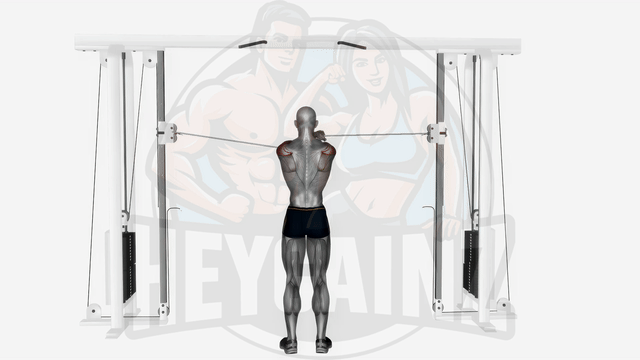
Instructions:
- 1Stand tall with your back straight and feet shoulder-width apart.
- 2Hold the cables in your opposite hands while extending your arms to shoulder height with your palms facing downward.
- 3Pull the cables by extending your arms wide apart.
- 4As your arms align with the shoulders, return to the initial position and repeat.
Tips:
- Keep your back nicely arched and avoid slouching.
- Keep your arms straight and avoid bending your elbows.
- Maintain a smooth breathing pattern and avoid breath-holding.
Cable Rear Delt Fly: A Comprehensive Guide
The cable rear delt fly is a highly effective exercise designed to target the rear deltoid muscles, helping to improve shoulder stability and promote a well-rounded physique. It is particularly beneficial for anyone looking to enhance their upper body strength or improve their posture. Whether performed with both arms or as a single-arm variation, this exercise can be adjusted to suit various fitness levels and goals.
Muscles Worked
The primary muscles engaged during the cable rear delt fly include:
- Rear Deltoids
- Upper Back Muscles
- Rhomboids
- Trapezius
This exercise also involves stabilizing muscles in the shoulders and upper arms, making it a comprehensive movement for building strength in the upper body.
Proper Form
To maximize the effectiveness of the cable rear delt fly while minimizing the risk of injury, it is essential to maintain proper form:
- Stand facing the cable machine with your feet shoulder-width apart.
- Adjust the pulleys to shoulder height and grasp the handles with a neutral grip.
- With a slight bend in the elbows, pull the cables out to the side while keeping your arms at shoulder level.
- Focus on squeezing the shoulder blades together as you pull.
- Slowly return to the starting position, maintaining control throughout the movement.
Setup Tips
Setting up for the cable rear delt fly correctly is crucial for optimal performance. Here are a few tips to consider:
- Ensure the cable machine is properly adjusted to your height.
- Start with a lighter weight to master the form before increasing the resistance.
- Incorporate various angles to target the muscles differently and maximize engagement.
Variations and Alternatives
For added variety or to focus on specific muscle groups, consider trying alternatives like the face pull. The cable rear delt fly and face pulls share similar muscle engagement but differ in execution and range of motion.
Conclusion
Integrating the cable rear delt fly into your workout routine can promote shoulder strength, stability, and overall aesthetic balance. Whether you're an experienced lifter or just starting, this exercise is a staple that can enhance your fitness journey. Explore the variations available, such as the single-arm cable rear delt fly, to keep your workouts engaging and effective.